"I soon became convinced... that all the theorizing would be empty brain exercise and therefore a waste of time unless one first ascertained what the population of the Universe really consists of." -Fritz Zwicky
Making the entire Universe isn't easy. Even with 13.7 billion years of time, general relativity and all the known particles in the Universe, we still can't reproduce all the observations we see today.
What does it take to get galaxies to form and cluster together the way they do in the Universe?
The large-scale structure in the Universe, from the earliest times when we formed the first atoms (and emitted the Cosmic Microwave Background) up through the present day and everywhere in between supports a Universe where only 4-5% of the energy content is delivered by known particles like protons, neutrons, electrons and photons. Add in neutrinos and all the other standard model particles we know, and you still can't explain the Universe the way we see it. There's got to be something else, and the best explanation we know of -- that all the data supports -- is that the Universe is filled with dark matter (to the tune of about 23%) and dark energy (which makes up the remaining 72-73%). Which means all the stuff we know, see, and are familiar with interacting with are insignificant when compared to the 95% of the Universe that's dark.
It's certainly not the most satisfying explanation you can concoct, but it fits the data in a way no alternative can. If this is correct, we should be able to test it!
We can then ask ourselves, given a Universe that did contain this much dark matter and dark energy, what should it look like, and what observational tests can we perform of these predictions?
If you wanted some of the newest answers to that question, you came to the right place.
We can simulate a Universe with varying quantities of dark matter and dark energy, and as you can clearly see from the (gorgeous) side-by-side video above, the formation of cosmic structure is very sensitive to the amount of dark matter and dark energy present in the Universe. We can look at what exists not only today, but at any stage in history, and if we've got the quantities right, our predictions should match up with the results at every stage.
Back in 2010, we took a look at what was -- at that point -- the largest dark matter survey in history, and were able to verify that the Universe needs both dark matter and dark energy in the above abundances to produce the structure we see today.
By measuring the bending of the light of background galaxies, due to the phenomenon of weak gravitational lensing, we can reconstruct how matter is distributed in the Universe. And we can answer the question of not just how much total matter is there (both luminous and dark), but how much dark energy is there, diluting the Universe through the effects of its accelerated expansion!
As the comparison below shows, we can definitively tell the difference between a Universe with and without dark energy.
Well, that was the COSMOS dark matter map back in 2010, and those results were impressive, groundbreaking, and the largest dark matter map ever made.
Earlier this week, the CFHTLenS team put those results to shame. Take a look at the latest, largest dark matter map of the Universe ever created, with the old map (and the Full Moon) shown to give you a sense of scale.
That's HUGE! This survey is about 100 square degrees on the sky, and future plans are to increase that area by a factor of 10 over the next three years by using the Very Large Telescope. Let's take a look -- to give you an idea of what this is actually looking at -- at the upper one-fourth of the dark matter map that's been reconstructed by this team. I'll show you the image in false color, to help make the gradations a little clearer.
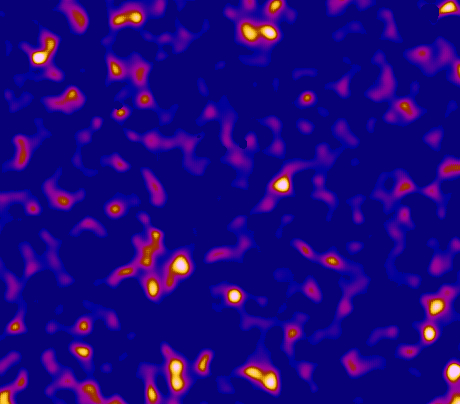
Each of these "bright yellow/white" spots that you're looking at takes up an area greater than the Full Moon on the sky, and is representative of a tremendous galaxy cluster, typically containing over a thousand galaxies. The reason we can measure the mass (and hence, create a dark matter map) is because we're also photographing light from distant galaxies that has traveled, on average, six billion years to get to us! All that intervening matter distorts that light, and by measuring just how that light gets distorted, we can reconstruct the intervening mass.
The results? They correlate amazingly well with the structure we observe. See for yourself.
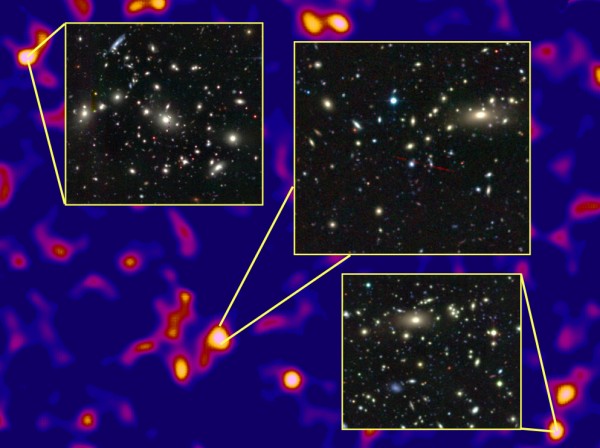
But what's really impressive is that we can reconstruct both the amount of dark matter and dark energy present in the Universe from this survey. It not only verifies the picture I've outlined for you above, but this one observation, on its own, is significant enough to rule out a Universe that doesn't have both dark matter and dark energy! (There's another team that's just completed a similar study, and while less visually stunning, their results are just as impressive. Shout-out to the SDSS team, Berkeley and Fermilab, and Eric Huff!)
And this isn't the only finding about dark matter that's just come out.
This behemoth, above, is known as El Gordo. The Universe was less than half it's present age when the light from El Gordo that reaches us today was emitted, and with 89 measured member galaxies despite its massive distance, El Gordo is the most distant ultramassive cluster of galaxies ever discovered.
The reddish hue to all the galaxies is actually due to the expansion of the Universe; these galaxies are intrinsically whitish-blue in color, but because the expanding Universe has had over seven billion years to redshift the light, what we observe comes out as an orangey color. But what's most remarkable about El Gordo? It's actually two massive, distant clusters, caught in the process of merging! How can we tell? Look with X-ray eyes!
That huge blue blur is the X-rays coming from this supercluster, courtesy of NASA's Chandra X-ray Observatory. Here's a more permanent view.
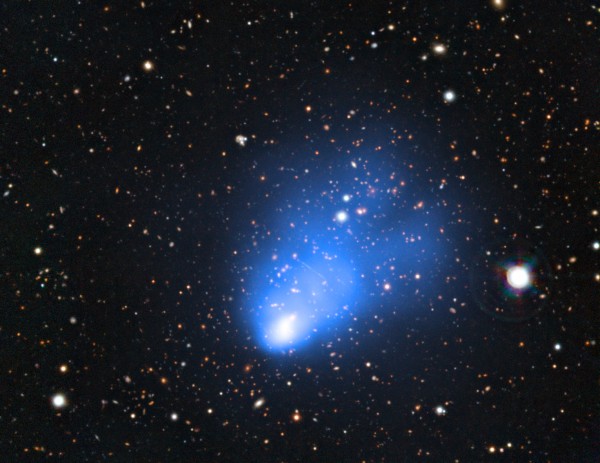
This is very exciting, because objects like this are super rare! How rare? To quote the research team:
Such a massive cluster at this redshift is rare, although consistent with the standard L-CDM cosmology in the lower part of its allowed mass range. Massive, high-redshift mergers like El Gordo are unlikely to be reproduced in the current generation of numerical N-body cosmological simulations.
In other words, this is pretty much one of the largest, earliest objects that should exist in the entire Universe, and if we someday find some object that's either much bigger or much younger than this, we may need to call our dark matter / dark energy Universe into question!
But there's one more spectacular find that dark matter fans should love. Let's take a look into the deepest recesses of the Universe, courtesy of the Hubble Space Telescope. (As always, click for the ultra hi-res version.)
These ultra-deep images from Hubble never fail to disappoint. (My fail; thanks, Cyan.) But what you're looking at here is a false-color image constructed from an orange filter (shown in blue), a near-infrared filter (shown in green), and a far-infrared filter (shown in red). The interesting thing in the image above are five of the most distant galaxies ever discovered; good luck to even the most image-savvy of you finding them.
Because these five ultra-distant galaxies are located at a redshift of eight, from a time when the Universe was only 650 million years old, or 5% of its current age! Give up?
This infant proto-cluster of galaxies has just five members visible to Hubble, yet this will very likely grow into an object not unlike our nearest structural giant: the 2,000-galaxy-containing Virgo Cluster. Each of these infant galaxies imaged by Hubble is significant smaller in size than our Milky Way, yet outshines it in terms of brightness, due to the incredible fraction of hot, young stars just forming. How does finding an object like this compare to our theoretical predictions of a Universe filled with dark matter and dark energy?
The result confirms our theoretical understanding of the buildup of galaxy clusters. And, Hubble is just powerful enough to find the first examples of them at this distance.
We need to look in many different areas because the odds of finding something this rare are very small. It's like playing a game of Battleship: the search is hit and miss. Typically, a region has nothing, but if we hit the right spot, we can find multiple galaxies.

BAM, Universe, Hubble just sank your battleship!
And there you have it; from a huge survey in our local neighborhood to large clusters billions of light years distant to the infancy of the Universe, dark matter (with an assist from dark energy) gives us predictions for what we should see, and as the new observations come in, everything fits. Score another one for science!


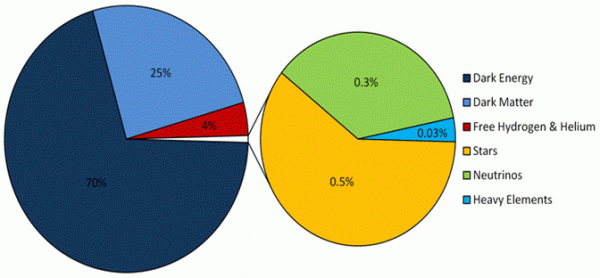
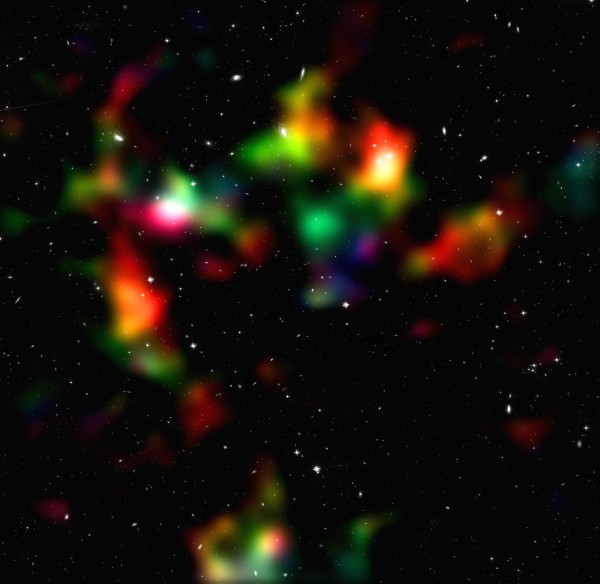
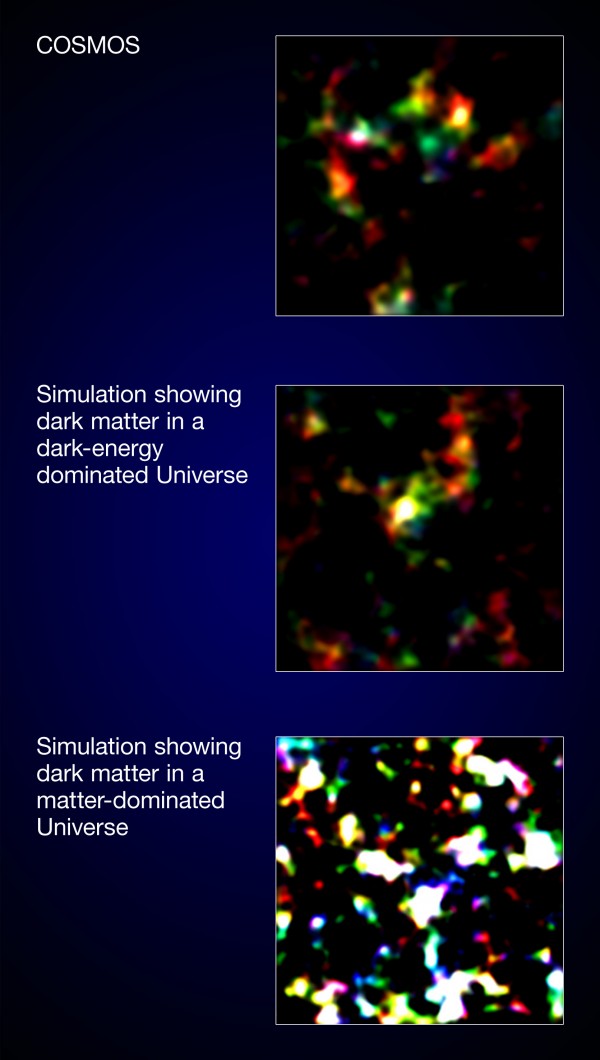
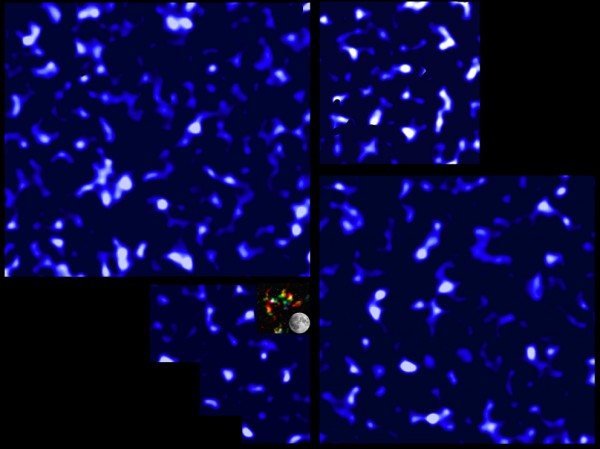
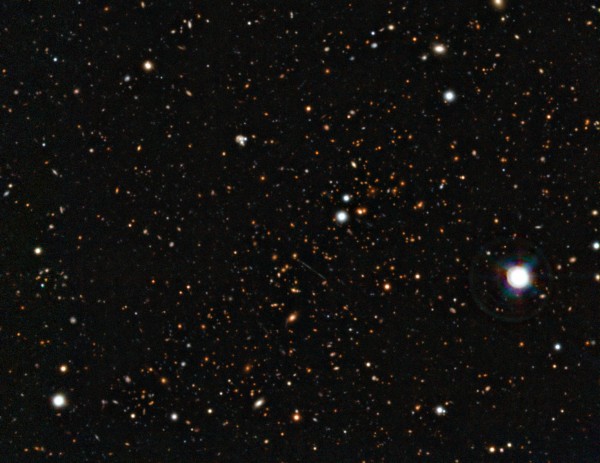
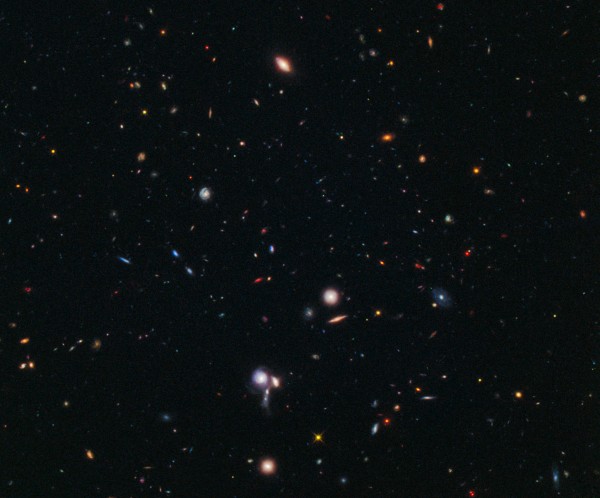
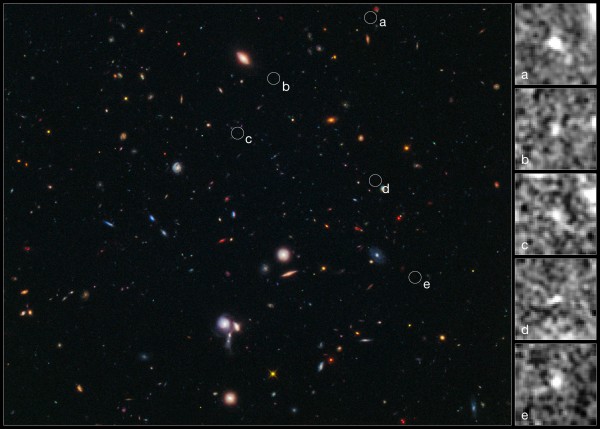
"These ultra-deep images from Hubble never fail to disappoint."
I think you mean they never disappoint.
(I really enjoy your blog -- thank you for writing it.)
Nice to see ever more observations consistent with dark stuff - hopefully shuts up some of the many cranks.
Just one thing
"...one of the largest, earliest objects that should exist in the entire Universe, and if..."
perhaps better
"...one of the largest, earliest objects that should have existed in the entire observable Universe, and if..."
or something like that.
Sascha @ 2: I feel like your splitting hairs. Seems like your attempted correction is redundant imho (emphasis on the o). I thought our entire universe consists of whats observable. Correct me if I'm wrong.
Side note: I love that I can come to this blog and not get bombarded with post after post about anti-vax. Seems like everyone's taking turns beating a crater into the ground that once was the location of a dead horse.
So the 2010 COSMOS dark matter map proved the existence of the Lights of Zetar?
Ethan,
I'm not sure if you have already commented on this or not but I would be interested in your take on how quantum gravity stacks up against dark matter being some kind of weakly interacting particle that is darn difficult to detect. For me anyway it seems more intuitive that we are missing something when it comes to gravity esp. on the quantum scale. Also the concept that there could be particles or energy hiding in higher dimensional spaces is just cooler but unfortunately according to Wikipedia we don't yet have a testable quantum gravity theory, which is a bummer.
Yes, very nice research. But...
The collection of dark matter observations is getting long and impressive; but we still only have a variety of hypothesis that aren't conclusive and conflict with each other sometimes.
Here is a summary in New Scientist Jan 9, 2012
http://www.newscientist.com/article/mg21328461.900-dark-matter-mysterie…
So what we got is a pretty good descriptive of some phenomenon(s) that seem(s) outside of currently accepted theory (so far conventional efforts, e.g. Cooperstock's work, have not been accepted). So the best working hypotheses suggest some new kind of matter(s); but we certainly don't have an accepted theory.
@2 Sasha
Which cranks are you referring too?
I mean take the time to educate us on what is crackpot and why and what hypotheses are not.
I'd like to put forth a mew concept for the creation of the universe. I find the big bang theory to be some what lacking in the department of where everything came from and starting from a pin point.
My theory is simple and might explain several things. I think we are in the core of a Ultra Super Black Hole that is feeding on the outside and has created a greater pull of gravity from the outer most surface that is ripping apart the inner most core. In other words, the inner core once densely pack with material is being drawn outward toward the outer surface of this massive black hole that we can't even imagine, leaving behind the remembrance of the once tightly packed core, our universe. Thus, the speeding expansion of the universe by an unknown force. The missing matter. The darkness of deep space, the outer shell of this black hole,making it impossible for us to see beyond it. The vacuum left behind by the pulling apart of the matter that had been crushed together and reduce to it's most basic form. And of course the reforming and forming of our universe within this core that is being pulled apart and still being tugged at by our surrounding black hole perhaps eating or joining with other Ultra Super Black Holes creating Super Gravitational Forces pulling apart the core. Our core, our universe. Stars and galaxies forming around romance of what was once our tightly packed center.
Perhaps too
the vastness of nothing creates it's own opposing energy in a never ending and ever changing positive and negative battle for superiority.
There may be other purposes and reasons for dark matter to exist. It may have had a completely different role, perhaps fundamental in the birth of the Universe, not just in the formation of galaxies...
My theory on the birth of the Universe - as an emergent phenomenon from self-organizing dark matter -
http://ydessays.blogspot.com/2012/01/case-for-emergence-as-cause-of-bir…
If we could re-do the big bang, with exactly the same conditions as the last one, would we wind up with exactly the same universe as we currently have? I suppose we'd have to make some assumptions... the butterfly effect, predetermined destiny, will and choice, etc. Finally, are there variables to constructing the universe that are outside said universe? You know, where gravity and dark matter comes from, for instance. Perhaps influence from your hypothetical multiverse.
This has been bugging me for weeks, and I'd like to get some sleep soon.
Why is it always the big bang? Why can't it be the big tare in the core of a black hole?